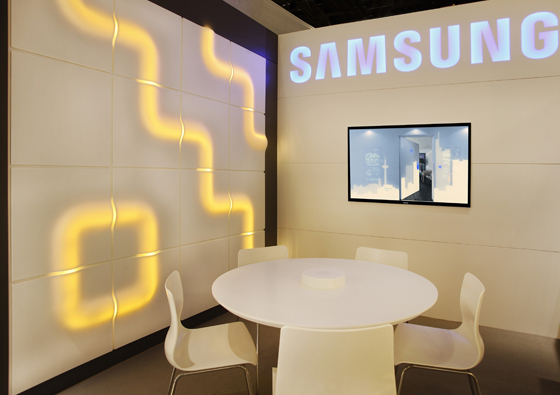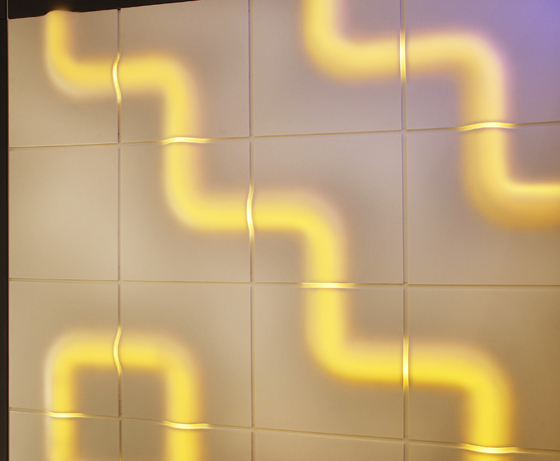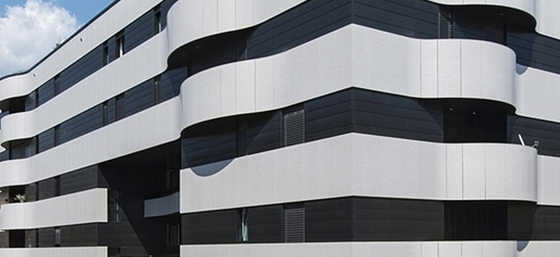Innovative STARON® Facade Cladding Points
Texto por Sascha Peters
Berlin, Alemania
05.02.15
Ever since the mid-nineties, flowing and organic forms that shape facade and roof design have been a prominent trend in contemporary architecture. Whereas in the past the implementation of special facade solutions required architects to cooperate with a whole series of different specialists, the design and construction of 3D facades has now been vastly simplified by an innovation developed by Lotte Chemical Deutschland
A white STARON® facade module (left) in combination with the insulating material FOAMGLAS® and LED backlighting at BAU 2015. In practice the modules can be mounted simply and in a single operation

A white STARON® facade module (left) in combination with the insulating material FOAMGLAS® and LED backlighting at BAU 2015. In practice the modules can be mounted simply and in a single operation
×Ever since the mid-nineties, flowing and organic forms that shape facade and roof design have been a prominent trend in contemporary architecture, with figures such as Frank Gehry, Zaha Hadid and Peter Cook as prominent practitioners of this formal architectural idiom. Whereas in the past the implementation of special facade solutions required architects to cooperate with a whole series of different specialists and partner companies, the design and construction of 3D facades has now been vastly simplified by an innovation developed by Lotte Chemical.
This highly individual integrated solution consisting of the mineral composite STARON® and the insulating material FOAMGLAS® celebrated its world premiere at BAU 2015. ‘With our new facade cladding, architects enjoy design flexibility both in 2D and 3D form,’ states Jürgen Lammers, Head of Business Development at Lotte Chemical. ‘Together with our partners we support architects in the realisation of their plans and ideas,’ adds Lammers. ‘We are currently implementing a wide range of checks in order to test the assembly systems and long-term functional capabilities of the modules. The developers have above all invested a great deal of time and energy in the adhesion process with which the facade modules are produced and applied to the substructure.’
On the basis of the architectural design the facade is divided by a computer programme into individual modules and is then produced and delivered as a single unit, which can be mounted in a single operation. ‘This is why STARON® is perfectly suited to the design of three-dimensional facades,’ states Lammers.
Translucent STARON® in three-dimensional form represents a unique departure in facade design.
STARON® consists of acrylic resin and the natural mineral aluminium hydroxide, which is obtained from bauxite. It has thermoplastic properties which give it the malleability of rubber at a temperature of 180 °C, and can then under vacuum conditions be shaped to almost any requirements, even three-dimensionally. STARON® cladding modules are available in more than eighty colour shades, but for the creation of facades that offer a high visual quality but make a minimalist impact most architects are currently applying classic white.
In the ready-to-use solution, the developers have integrated end-to-end insulating layers made of non-combustible FOAMGLAS®, a material which is impermeable to water or vapour and ensures a homogeneous design without thermal bridges. For architects, the extensive proportion of prefabrication reduces the work involved in coordination and accordingly simplifies the process of implementing projects, with special mounting and adhesion systems making the 3D facade easy to assemble. The application of versatile milling technology and the integration of lighting systems produce innovative colour and lighting effects which enhance the three-dimensional design.
The rear-ventilated STARON® facade emphasises the strict geometrical lines
‘During the coming weeks we will integrate the reactions and wishes which have been expressed by architects and project developers at BAU 2015 into our future planning and product development operations,’ comments Jürgen Lammers, ‘because this feedback enables optimum development with and for the customer’.
STARON® Solid Surfaces is manufactured in South Korea and is sold in the form of styrene-free, acrylic-based solid panels and moulded sections with mineral filling material. Its main areas of application include the design of hotels, restaurants, office facilities and the construction of walls and facades.
At BAU 2015 in Munich, Lotte Chemical for the first time presented system solutions which use STARON® in a range of building applications. In the creation of integrated facade systems, STARON® is able to resort to a network of partner companies for the purpose of enabling architects to implement projects both quickly and free from complications.
---




